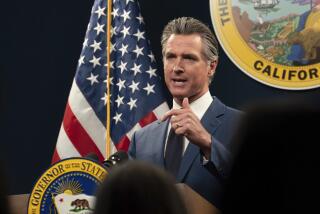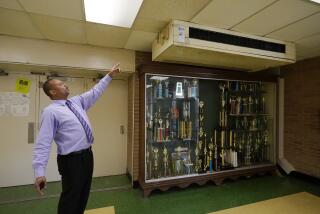Still Broke, Michigan School Fights to...
- Share via
KALKASKA, Mich. — Driving 10-year-old Kim to school before continuing on to work has become second nature for Irene Beltnick. She’s been doing it since September, when Kalkaska schools cut bus service to save money.
Getting Kim home each afternoon can be trickier, but they manage.
“It just takes a little more planning and forethought,” Beltnick said with a resigned smile as her daughter bounced from the car outside Birch Street Elementary School.
The struggle continues in Kalkaska, the small factory town and retirement haven in northern Michigan that lost its anonymity a year ago when school closed 10 weeks early.
With money running out and irate taxpayers refusing to give more, officials chose a shortened calendar over the deep program cuts necessary to operate a full 180-day year. On March 24, students began “summer vacation” with snow on the ground.
Since then, voters twice have shot down attempts to raise property taxes. But officials of the 2,100-student district say this time they will muddle through until the scheduled closing June 3.
The school board last fall reluctantly accepted cuts it previously had rejected--eliminating bus service, cutting nearly 50 jobs, slashing the athletics budget and charging players $50 per sport. A number of other Michigan districts have done likewise.
Still, this year’s $8.6-million budget is $500,000 in the hole because of state aid cuts and rising costs, Kalkaska Supt. Doyle Disbrow said. There will be a $300,000 deficit next year even if the spending cuts remain and a salary freeze continues, he said.
Shortening the year by more than 20% made Kalkaska a symbol of money problems afflicting the nation’s public schools.
“It awakened people even more than they had been previously to the seriousness of the problem,” said Bob Chase, vice president of the National Education Assn.
The teachers’ group supported Kalkaska’s early closure. Critics in the Legislature and Gov. John Engler’s administration said it was unnecessary and accused the school administration of mismanagement. Forbes magazine labeled the move “a union-orchestrated stunt” aimed at blackmailing taxpayers with children as hostages.
But even critics acknowledge it may have been the final straw leading to the Legislature’s abrupt decision last summer to dump the property tax as the chief source of education funding in Michigan.
The move ended a 20-year stalemate over fixing a system that produced increasingly wide funding gaps among the state’s school districts.
“They’d have muddled right along, doing nothing, if we hadn’t acted,” said Rik Ponstein, head of the Kalkaska teachers’ union.
Now Michigan voters must choose a new funding system.
A statewide referendum will be held Tuesday on Proposal A, which would boost the sales tax from 4% to 6%. It would retain a token tax on residences and a bigger levy on business property and would triple the cigarette tax to 75 cents a pack.
If the proposal loses, the Legislature has approved a fallback plan to raise the state income tax from 4.6% to 6%, levy some property taxes and increase taxes on cigarettes and other items.
In Kalkaska, the coming vote has generated little of the passion stirred by local property tax campaigns. Few seem convinced that Proposal A or the fallback plan would solve their schools’ money woes.
“They don’t come anywhere close,” Disbrow said. He predicted Kalkaska and dozens of other districts would not have enough money next year to continue their current programs.
Mike Addonizio, state assistant school superintendent, said many districts might consider their funding inadequate under the new system. But he said it will boost state education spending from $9.6 billion to $10.2 billion next year while other programs will be lucky to avoid cuts.
Proposal A and the fallback plan promise each district a minimum grant of $4,200 per pupil next year, rising to $5,000 within five years.
Kalkaska spends about $3,800 per pupil now, so next year’s total figures to be about 10% higher. The average district’s increase will be around 5.2%, Addonizio said.
Kalkaska’s boost may seem generous, Disbrow said. But he contends it still won’t buy a quality program because the district is so far behind.
“Nobody would say they’ll be on easy street,” Addonizio said. “But they’re getting a bigger per-pupil revenue increase than most districts around the state.”
Whatever happens, Kalkaskans say they’ve learned to make the best of things. When school ended prematurely, some parents tutored children in a church basement. When the buses were grounded, they formed car pools. When the band needed new uniforms, they held a beef-stew dinner to raise money.
“People get the impression this is a little hick place that can’t take care of itself,” said Alan Belt, father of two students. “We’ve really pulled together.”
More to Read
Sign up for Essential California
The most important California stories and recommendations in your inbox every morning.
You may occasionally receive promotional content from the Los Angeles Times.













